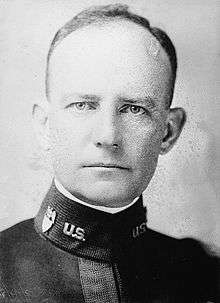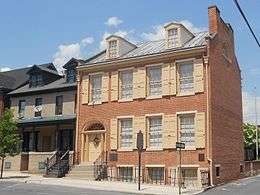Frank Ross McCoy
| Frank Ross McCoy | |
|---|---|
 Frank R. McCoy | |
| Born |
October 29, 1874 Lewistown, Pennsylvania |
| Died |
June 4, 1954 (aged 79) Washington, D.C. |
| Place of burial | Arlington National Cemetery |
| Allegiance |
|
| Service/branch |
|
| Years of service | 1897–1938; 1941–1942 |
| Rank |
|
| Commands held |
VII Corps Second Army II Corps |
| Battles/wars |
Spanish–American War *Battle of San Juan Hill Philippine–American War Bandit War World War I |
| Other work |
President, Foreign Policy Association (1939-1945) Chairman, Far Eastern Commission (1951-1954) |
Frank Ross McCoy (October 29, 1874 – June 4, 1954) was an American Army officer. He served in the Philippines, during World War I, and led an American relief mission to Tokyo after the 1923 earthquake. He retired from military service in 1938. In his civilian career, he was president of the Foreign Policy Association and chairman of the Far Eastern Commission.
Early life
He was born in Lewistown, Pennsylvania on October 29, 1874. He graduated from the United States Military Academy in 1897, was commissioned a 2nd Lieutenant and appointed to the 8th Cavalry.[1]
Military career
He served on the western front in Cuba, in the Philippines, and in the Santiago campaign. In Cuba and in the Philippines, he acted as aide to General Wood and was for several years aide to President Roosevelt after his promotion to Major General.[1]
In 1911, he was appointed a member of the General Staff, and in 1917, became a member of the General Staff of the American Expeditionary Force in Europe, where he commanded the 165th Infantry Regiment in 1918.[2]
He wrote: Principles of Military Training (1917).[3]
From 1918 to 1919, he was Director of Transportation in the American Expeditionary Force. In 1919, he served as chief of staff in the American military mission to Armenia. He led a relief mission to Tokyo after the 1923 earthquake. From 1926 to 1929, he commanded the 3rd Infantry Brigade and the 1st Field Artillery Brigade. From 1932 to 1933, he served on the Lytton Commission investigating the Japanese military invasion and occupation of Manchuria.[2]
He served as interim commander of First United States Army in 1938, and was succeeded by James K. Parsons. He retired on October 31, 1938,[4] but was recalled between 1941 and 1942 to serve on the Roberts Commission.
Civilian career
After the war, he became the chairman of the Far Eastern Commission, an international body created to determine the fate of postwar Japan.[1]
Awards
He received the Army Distinguished Service Medal[5] and 2 Silver Star Citations.[5]
Death
He died on June 4, 1954 at Walter Reed Army Medical Center.[2]
Legacy

His birthplace, the McCoy House, was added to the National Register of Historic Places in 1973.[6]
His papers are held by the Library of Congress.[7]
References
- 1 2 3 Davis, Jr., Henry Blaine (1998). Generals in Khaki. Pentland Press, Inc. p. 253. ISBN 1571970886. OCLC 40298151.
- 1 2 3 Davis, Jr., Henry Blaine (1998). Generals in Khaki. Pentland Press, Inc. p. 253. ISBN 1571970886. OCLC 40298151.
- ↑ McCoy, Frank Ross. Principles of Military Training. [New York]: [P.F. Collier & Sons], 1917. OCLC 260320036
- ↑ Davis, Jr., Henry Blaine (1998). Generals in Khaki. Pentland Press, Inc. p. 253. ISBN 1571970886. OCLC 40298151.
- 1 2 "Valor awards for Frank Ross McCoy".
- ↑ National Park Service (2010-07-09). "National Register Information System". National Register of Historic Places. National Park Service.
- ↑ McCoy, Frank Ross. "Frank Ross McCoy papers, 1847-1957".
- "GEN. DRUM TO COMMAND SECOND CORPS AREA; Will Relieve General McCoy, Who Is Retiring, Here", New York Times, September 14, 1938
- Diplomat in Khaki: Major General Frank Ross McCoy and American Foreign Policy, 1898–1949, Andrew Bacevich, 1989, ISBN 0-7006-0401-4